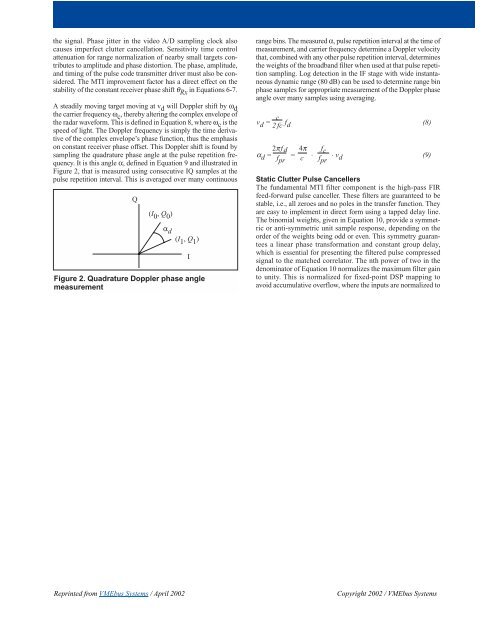VME 2100 Apr 02 PDF - VITA Technologies
VME 2100 Apr 02 PDF - VITA Technologies
VME 2100 Apr 02 PDF - VITA Technologies
You also want an ePaper? Increase the reach of your titles
YUMPU automatically turns print PDFs into web optimized ePapers that Google loves.
the signal. Phase jitter in the video A/D sampling clock also<br />
causes imperfect clutter cancellation. Sensitivity time control<br />
attenuation for range normalization of nearby small targets contributes<br />
to amplitude and phase distortion. The phase, amplitude,<br />
and timing of the pulse code transmitter driver must also be considered.<br />
The MTI improvement factor has a direct effect on the<br />
stability of the constant receiver phase shift θ Rx in Equations 6-7.<br />
A steadily moving target moving at v d will Doppler shift by ω d<br />
the carrier frequency ω c , thereby altering the complex envelope of<br />
the radar waveform. This is defined in Equation 8, where ω c is the<br />
speed of light. The Doppler frequency is simply the time derivative<br />
of the complex envelope’s phase function, thus the emphasis<br />
on constant receiver phase offset. This Doppler shift is found by<br />
sampling the quadrature phase angle at the pulse repetition frequency.<br />
It is this angle α, defined in Equation 9 and illustrated in<br />
Figure 2, that is measured using consecutive IQ samples at the<br />
pulse repetition interval. This is averaged over many continuous<br />
Q<br />
(I 0 , Q 0 )<br />
d<br />
(I 1 , Q 1 )<br />
Figure 2. Quadrature Doppler phase angle<br />
measurement<br />
I<br />
range bins. The measured α, pulse repetition interval at the time of<br />
measurement, and carrier frequency determine a Doppler velocity<br />
that, combined with any other pulse repetition interval, determines<br />
the weights of the broadband filter when used at that pulse repetition<br />
sampling. Log detection in the IF stage with wide instantaneous<br />
dynamic range (80 dB) can be used to determine range bin<br />
phase samples for appropriate measurement of the Doppler phase<br />
angle over many samples using averaging.<br />
c<br />
v d = 2fc<br />
f d (8)<br />
2πfd 4π f<br />
α d = fpr<br />
= . c<br />
. c f<br />
v pr d (9)<br />
Static Clutter Pulse Cancellers<br />
The fundamental MTI filter component is the high-pass FIR<br />
feed-forward pulse canceller. These filters are guaranteed to be<br />
stable, i.e., all zeroes and no poles in the transfer function. They<br />
are easy to implement in direct form using a tapped delay line.<br />
The binomial weights, given in Equation 10, provide a symmetric<br />
or anti-symmetric unit sample response, depending on the<br />
order of the weights being odd or even. This symmetry guarantees<br />
a linear phase transformation and constant group delay,<br />
which is essential for presenting the filtered pulse compressed<br />
signal to the matched correlator. The nth power of two in the<br />
denominator of Equation 10 normalizes the maximum filter gain<br />
to unity. This is normalized for fixed-point DSP mapping to<br />
avoid accumulative overflow, where the inputs are normalized to<br />
Reprinted from <strong>VME</strong>bus Systems / <strong>Apr</strong>il 20<strong>02</strong><br />
Copyright 20<strong>02</strong> / <strong>VME</strong>bus Systems
















